mirror CHEVROLET COBALT 2007 1.G Owners Manual
[x] Cancel search | Manufacturer: CHEVROLET, Model Year: 2007, Model line: COBALT, Model: CHEVROLET COBALT 2007 1.GPages: 450, PDF Size: 2.48 MB
Page 1 of 450
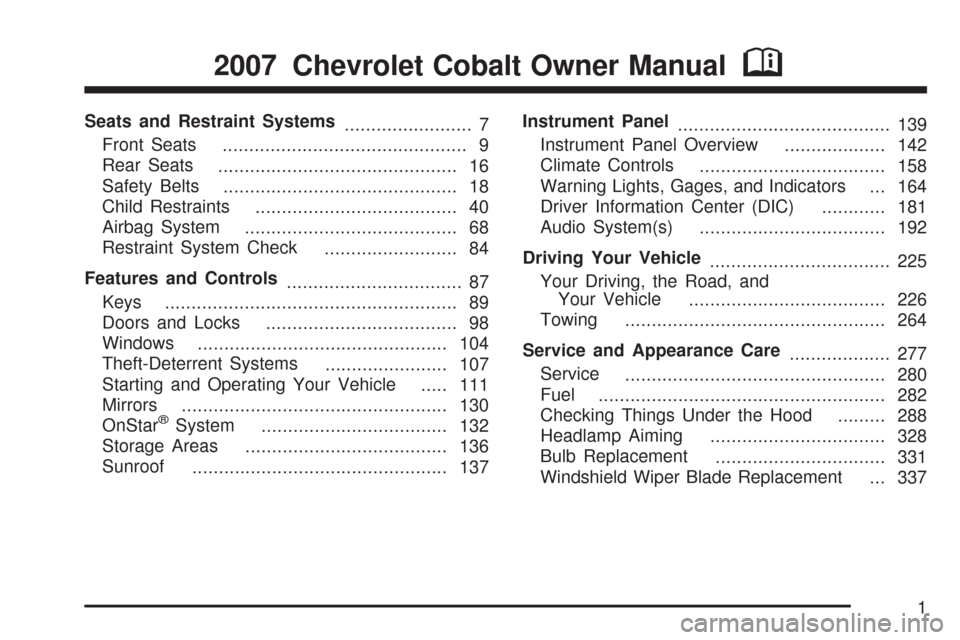
Seats and Restraint Systems
........................ 7
Front Seats
.............................................. 9
Rear Seats
............................................. 16
Safety Belts
............................................ 18
Child Restraints
...................................... 40
Airbag System
........................................ 68
Restraint System Check
......................... 84
Features and Controls
................................. 87
Keys
....................................................... 89
Doors and Locks
.................................... 98
Windows
............................................... 104
Theft-Deterrent Systems
....................... 107
Starting and Operating Your Vehicle
..... 111
Mirrors
.................................................. 130
OnStar
®System
................................... 132
Storage Areas
...................................... 136
Sunroof
................................................ 137Instrument Panel
........................................ 139
Instrument Panel Overview
................... 142
Climate Controls
................................... 158
Warning Lights, Gages, and Indicators
... 164
Driver Information Center (DIC)
............ 181
Audio System(s)
................................... 192
Driving Your Vehicle
.................................. 225
Your Driving, the Road, and
Your Vehicle
..................................... 226
Towing
................................................. 264
Service and Appearance Care
................... 277
Service
................................................. 280
Fuel
...................................................... 282
Checking Things Under the Hood
......... 288
Headlamp Aiming
................................. 328
Bulb Replacement
................................ 331
Windshield Wiper Blade Replacement
... 337
2007 Chevrolet Cobalt Owner ManualM
1
Page 88 of 450
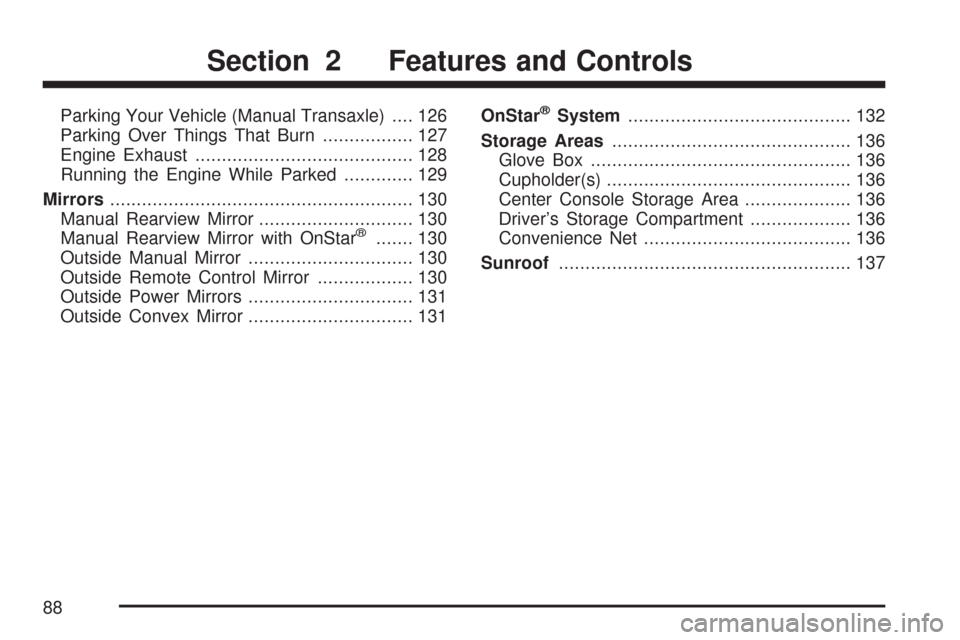
Parking Your Vehicle (Manual Transaxle).... 126
Parking Over Things That Burn................. 127
Engine Exhaust......................................... 128
Running the Engine While Parked............. 129
Mirrors......................................................... 130
Manual Rearview Mirror............................. 130
Manual Rearview Mirror with OnStar
®....... 130
Outside Manual Mirror............................... 130
Outside Remote Control Mirror.................. 130
Outside Power Mirrors............................... 131
Outside Convex Mirror............................... 131OnStar
®System.......................................... 132
Storage Areas............................................. 136
Glove Box................................................. 136
Cupholder(s).............................................. 136
Center Console Storage Area.................... 136
Driver’s Storage Compartment................... 136
Convenience Net....................................... 136
Sunroof....................................................... 137
Section 2 Features and Controls
88
Page 106 of 450
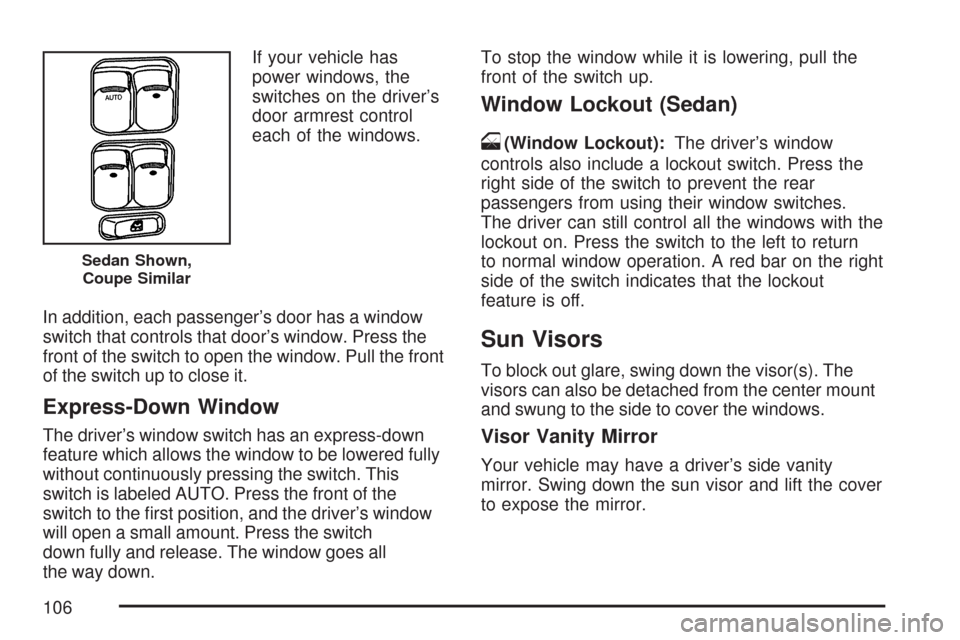
If your vehicle has
power windows, the
switches on the driver’s
door armrest control
each of the windows.
In addition, each passenger’s door has a window
switch that controls that door’s window. Press the
front of the switch to open the window. Pull the front
of the switch up to close it.
Express-Down Window
The driver’s window switch has an express-down
feature which allows the window to be lowered fully
without continuously pressing the switch. This
switch is labeled AUTO. Press the front of the
switch to the �rst position, and the driver’s window
will open a small amount. Press the switch
down fully and release. The window goes all
the way down.To stop the window while it is lowering, pull the
front of the switch up.
Window Lockout (Sedan)
o
(Window Lockout):The driver’s window
controls also include a lockout switch. Press the
right side of the switch to prevent the rear
passengers from using their window switches.
The driver can still control all the windows with the
lockout on. Press the switch to the left to return
to normal window operation. A red bar on the right
side of the switch indicates that the lockout
feature is off.
Sun Visors
To block out glare, swing down the visor(s). The
visors can also be detached from the center mount
and swung to the side to cover the windows.
Visor Vanity Mirror
Your vehicle may have a driver’s side vanity
mirror. Swing down the sun visor and lift the cover
to expose the mirror.
Sedan Shown,
Coupe Similar
106
Page 130 of 450
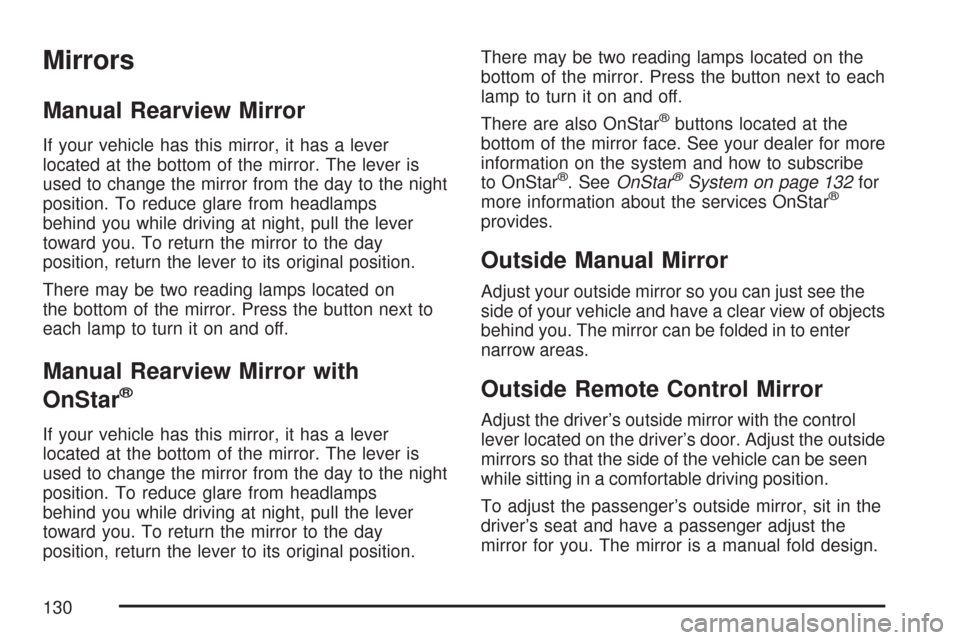
Mirrors
Manual Rearview Mirror
If your vehicle has this mirror, it has a lever
located at the bottom of the mirror. The lever is
used to change the mirror from the day to the night
position. To reduce glare from headlamps
behind you while driving at night, pull the lever
toward you. To return the mirror to the day
position, return the lever to its original position.
There may be two reading lamps located on
the bottom of the mirror. Press the button next to
each lamp to turn it on and off.
Manual Rearview Mirror with
OnStar
®
If your vehicle has this mirror, it has a lever
located at the bottom of the mirror. The lever is
used to change the mirror from the day to the night
position. To reduce glare from headlamps
behind you while driving at night, pull the lever
toward you. To return the mirror to the day
position, return the lever to its original position.There may be two reading lamps located on the
bottom of the mirror. Press the button next to each
lamp to turn it on and off.
There are also OnStar
®buttons located at the
bottom of the mirror face. See your dealer for more
information on the system and how to subscribe
to OnStar
®. SeeOnStar®System on page 132for
more information about the services OnStar®
provides.
Outside Manual Mirror
Adjust your outside mirror so you can just see the
side of your vehicle and have a clear view of objects
behind you. The mirror can be folded in to enter
narrow areas.
Outside Remote Control Mirror
Adjust the driver’s outside mirror with the control
lever located on the driver’s door. Adjust the outside
mirrors so that the side of the vehicle can be seen
while sitting in a comfortable driving position.
To adjust the passenger’s outside mirror, sit in the
driver’s seat and have a passenger adjust the
mirror for you. The mirror is a manual fold design.
130
Page 131 of 450
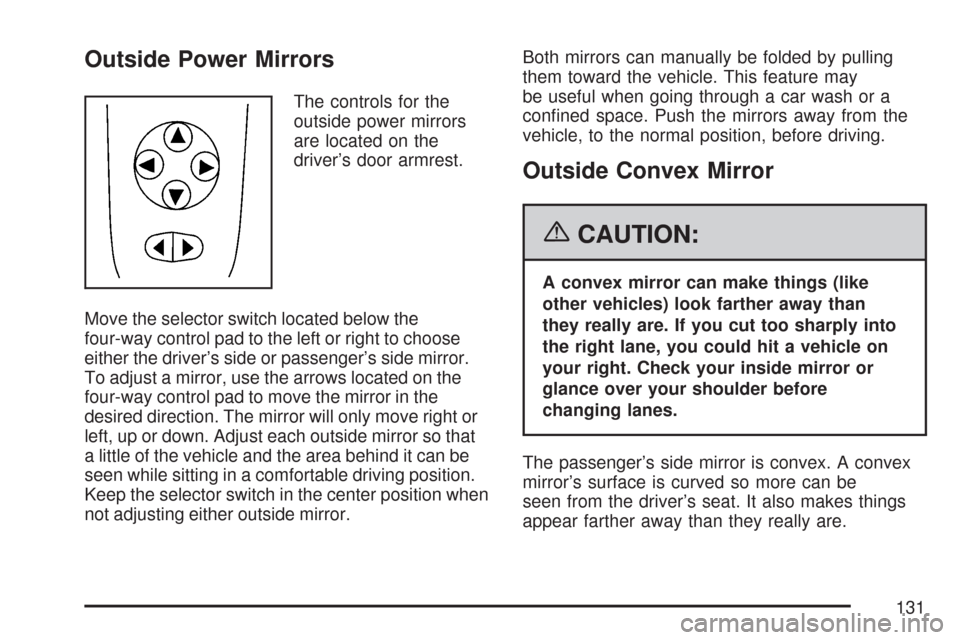
Outside Power Mirrors
The controls for the
outside power mirrors
are located on the
driver’s door armrest.
Move the selector switch located below the
four-way control pad to the left or right to choose
either the driver’s side or passenger’s side mirror.
To adjust a mirror, use the arrows located on the
four-way control pad to move the mirror in the
desired direction. The mirror will only move right or
left, up or down. Adjust each outside mirror so that
a little of the vehicle and the area behind it can be
seen while sitting in a comfortable driving position.
Keep the selector switch in the center position when
not adjusting either outside mirror.Both mirrors can manually be folded by pulling
them toward the vehicle. This feature may
be useful when going through a car wash or a
con�ned space. Push the mirrors away from the
vehicle, to the normal position, before driving.
Outside Convex Mirror
{CAUTION:
A convex mirror can make things (like
other vehicles) look farther away than
they really are. If you cut too sharply into
the right lane, you could hit a vehicle on
your right. Check your inside mirror or
glance over your shoulder before
changing lanes.
The passenger’s side mirror is convex. A convex
mirror’s surface is curved so more can be
seen from the driver’s seat. It also makes things
appear farther away than they really are.
131
Page 139 of 450
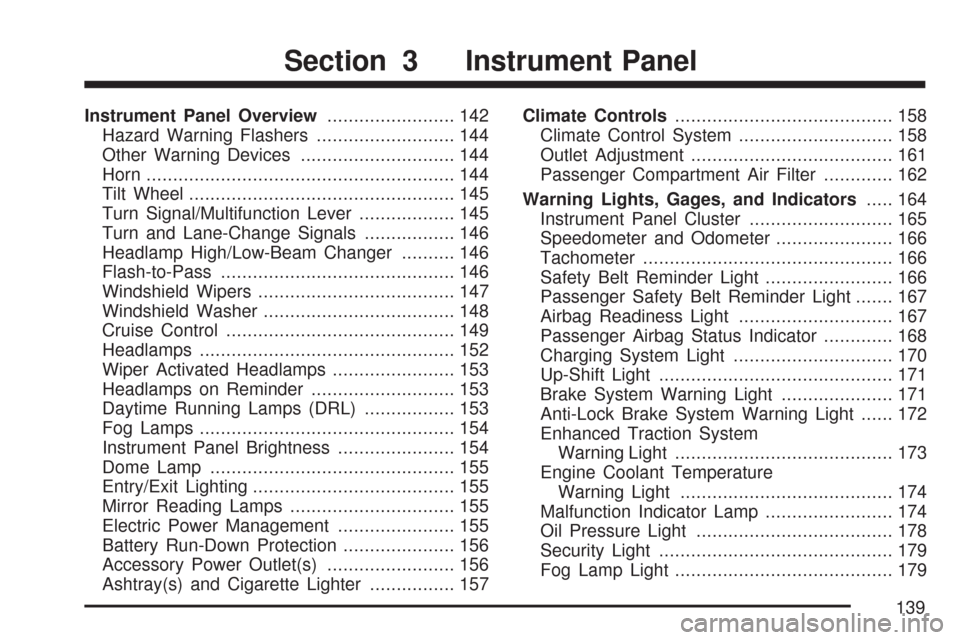
Instrument Panel Overview........................ 142
Hazard Warning Flashers.......................... 144
Other Warning Devices............................. 144
Horn.......................................................... 144
Tilt Wheel.................................................. 145
Turn Signal/Multifunction Lever.................. 145
Turn and Lane-Change Signals................. 146
Headlamp High/Low-Beam Changer.......... 146
Flash-to-Pass............................................ 146
Windshield Wipers..................................... 147
Windshield Washer.................................... 148
Cruise Control........................................... 149
Headlamps................................................ 152
Wiper Activated Headlamps....................... 153
Headlamps on Reminder........................... 153
Daytime Running Lamps (DRL)................. 153
Fog Lamps................................................ 154
Instrument Panel Brightness...................... 154
Dome Lamp.............................................. 155
Entry/Exit Lighting...................................... 155
Mirror Reading Lamps............................... 155
Electric Power Management...................... 155
Battery Run-Down Protection..................... 156
Accessory Power Outlet(s)........................ 156
Ashtray(s) and Cigarette Lighter................ 157Climate Controls......................................... 158
Climate Control System............................. 158
Outlet Adjustment...................................... 161
Passenger Compartment Air Filter............. 162
Warning Lights, Gages, and Indicators..... 164
Instrument Panel Cluster........................... 165
Speedometer and Odometer...................... 166
Tachometer............................................... 166
Safety Belt Reminder Light........................ 166
Passenger Safety Belt Reminder Light....... 167
Airbag Readiness Light............................. 167
Passenger Airbag Status Indicator............. 168
Charging System Light.............................. 170
Up-Shift Light............................................ 171
Brake System Warning Light..................... 171
Anti-Lock Brake System Warning Light...... 172
Enhanced Traction System
Warning Light......................................... 173
Engine Coolant Temperature
Warning Light........................................ 174
Malfunction Indicator Lamp........................ 174
Oil Pressure Light..................................... 178
Security Light............................................ 179
Fog Lamp Light......................................... 179
Section 3 Instrument Panel
139
Page 155 of 450
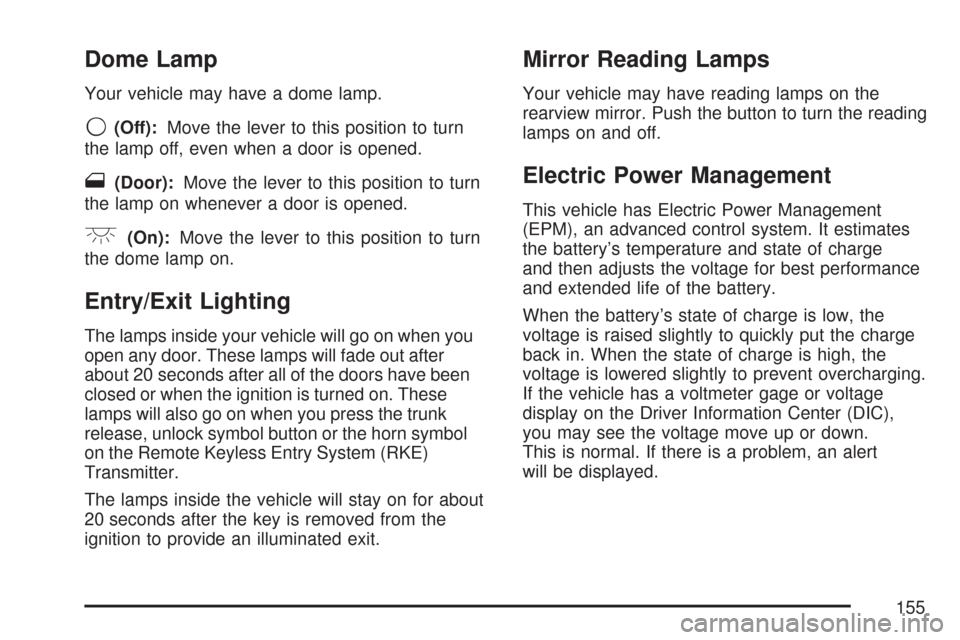
Dome Lamp
Your vehicle may have a dome lamp.
9(Off):Move the lever to this position to turn
the lamp off, even when a door is opened.
1(Door):Move the lever to this position to turn
the lamp on whenever a door is opened.
+(On):Move the lever to this position to turn
the dome lamp on.
Entry/Exit Lighting
The lamps inside your vehicle will go on when you
open any door. These lamps will fade out after
about 20 seconds after all of the doors have been
closed or when the ignition is turned on. These
lamps will also go on when you press the trunk
release, unlock symbol button or the horn symbol
on the Remote Keyless Entry System (RKE)
Transmitter.
The lamps inside the vehicle will stay on for about
20 seconds after the key is removed from the
ignition to provide an illuminated exit.
Mirror Reading Lamps
Your vehicle may have reading lamps on the
rearview mirror. Push the button to turn the reading
lamps on and off.
Electric Power Management
This vehicle has Electric Power Management
(EPM), an advanced control system. It estimates
the battery’s temperature and state of charge
and then adjusts the voltage for best performance
and extended life of the battery.
When the battery’s state of charge is low, the
voltage is raised slightly to quickly put the charge
back in. When the state of charge is high, the
voltage is lowered slightly to prevent overcharging.
If the vehicle has a voltmeter gage or voltage
display on the Driver Information Center (DIC),
you may see the voltage move up or down.
This is normal. If there is a problem, an alert
will be displayed.
155
Page 241 of 450
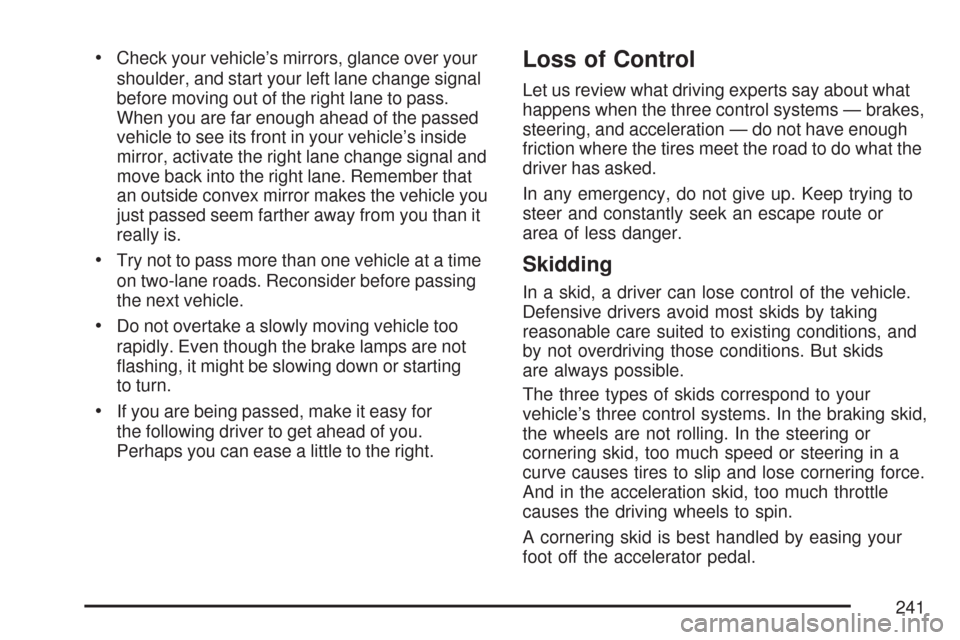
Check your vehicle’s mirrors, glance over your
shoulder, and start your left lane change signal
before moving out of the right lane to pass.
When you are far enough ahead of the passed
vehicle to see its front in your vehicle’s inside
mirror, activate the right lane change signal and
move back into the right lane. Remember that
an outside convex mirror makes the vehicle you
just passed seem farther away from you than it
really is.
Try not to pass more than one vehicle at a time
on two-lane roads. Reconsider before passing
the next vehicle.
Do not overtake a slowly moving vehicle too
rapidly. Even though the brake lamps are not
�ashing, it might be slowing down or starting
to turn.
If you are being passed, make it easy for
the following driver to get ahead of you.
Perhaps you can ease a little to the right.
Loss of Control
Let us review what driving experts say about what
happens when the three control systems — brakes,
steering, and acceleration — do not have enough
friction where the tires meet the road to do what the
driver has asked.
In any emergency, do not give up. Keep trying to
steer and constantly seek an escape route or
area of less danger.
Skidding
In a skid, a driver can lose control of the vehicle.
Defensive drivers avoid most skids by taking
reasonable care suited to existing conditions, and
by not overdriving those conditions. But skids
are always possible.
The three types of skids correspond to your
vehicle’s three control systems. In the braking skid,
the wheels are not rolling. In the steering or
cornering skid, too much speed or steering in a
curve causes tires to slip and lose cornering force.
And in the acceleration skid, too much throttle
causes the driving wheels to spin.
A cornering skid is best handled by easing your
foot off the accelerator pedal.
241
Page 242 of 450
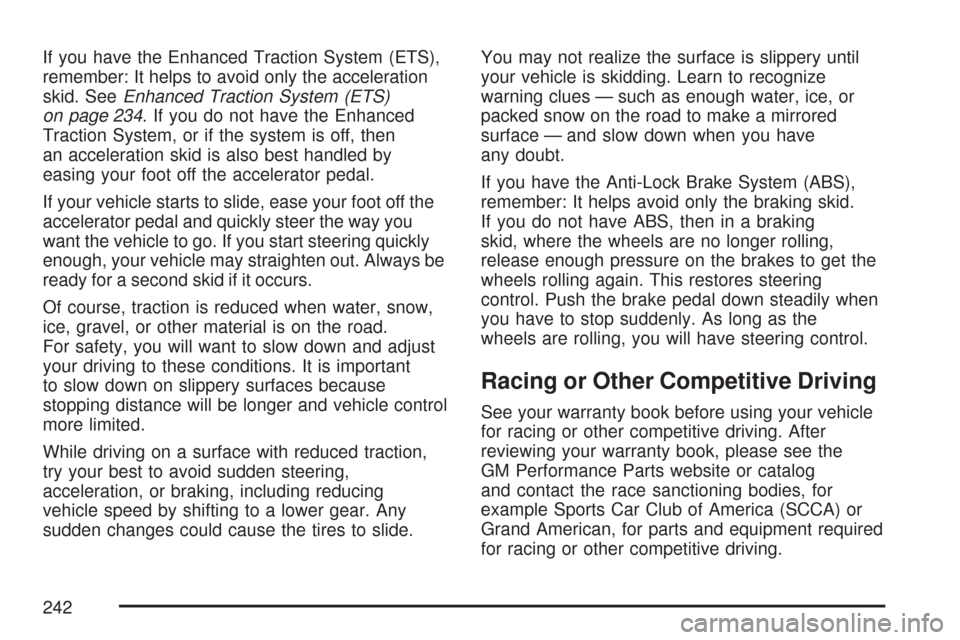
If you have the Enhanced Traction System (ETS),
remember: It helps to avoid only the acceleration
skid. SeeEnhanced Traction System (ETS)
on page 234. If you do not have the Enhanced
Traction System, or if the system is off, then
an acceleration skid is also best handled by
easing your foot off the accelerator pedal.
If your vehicle starts to slide, ease your foot off the
accelerator pedal and quickly steer the way you
want the vehicle to go. If you start steering quickly
enough, your vehicle may straighten out. Always be
ready for a second skid if it occurs.
Of course, traction is reduced when water, snow,
ice, gravel, or other material is on the road.
For safety, you will want to slow down and adjust
your driving to these conditions. It is important
to slow down on slippery surfaces because
stopping distance will be longer and vehicle control
more limited.
While driving on a surface with reduced traction,
try your best to avoid sudden steering,
acceleration, or braking, including reducing
vehicle speed by shifting to a lower gear. Any
sudden changes could cause the tires to slide.You may not realize the surface is slippery until
your vehicle is skidding. Learn to recognize
warning clues — such as enough water, ice, or
packed snow on the road to make a mirrored
surface — and slow down when you have
any doubt.
If you have the Anti-Lock Brake System (ABS),
remember: It helps avoid only the braking skid.
If you do not have ABS, then in a braking
skid, where the wheels are no longer rolling,
release enough pressure on the brakes to get the
wheels rolling again. This restores steering
control. Push the brake pedal down steadily when
you have to stop suddenly. As long as the
wheels are rolling, you will have steering control.
Racing or Other Competitive Driving
See your warranty book before using your vehicle
for racing or other competitive driving. After
reviewing your warranty book, please see the
GM Performance Parts website or catalog
and contact the race sanctioning bodies, for
example Sports Car Club of America (SCCA) or
Grand American, for parts and equipment required
for racing or other competitive driving.
242
Page 243 of 450
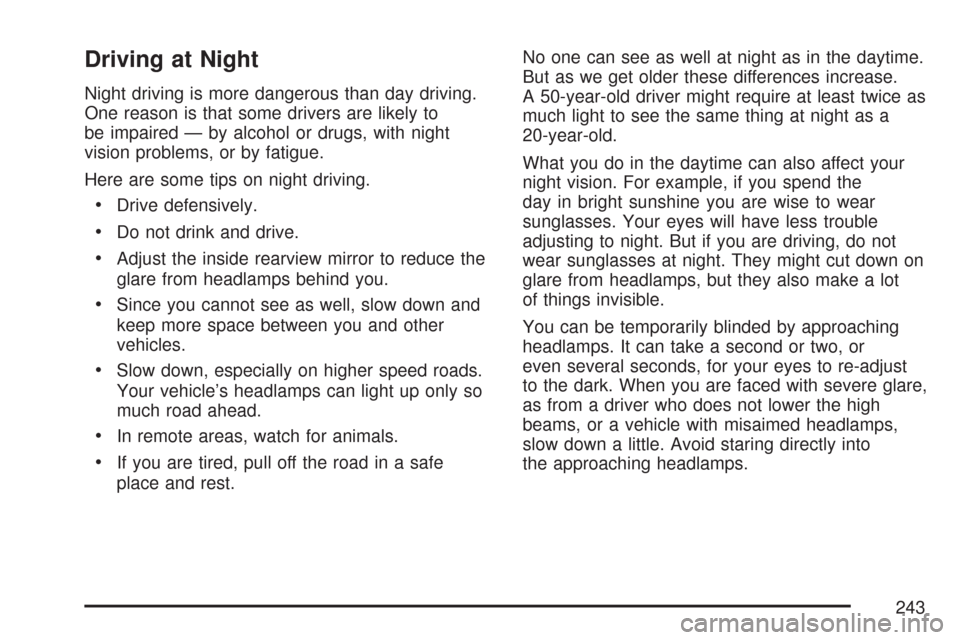
Driving at Night
Night driving is more dangerous than day driving.
One reason is that some drivers are likely to
be impaired — by alcohol or drugs, with night
vision problems, or by fatigue.
Here are some tips on night driving.
Drive defensively.
Do not drink and drive.
Adjust the inside rearview mirror to reduce the
glare from headlamps behind you.
Since you cannot see as well, slow down and
keep more space between you and other
vehicles.
Slow down, especially on higher speed roads.
Your vehicle’s headlamps can light up only so
much road ahead.
In remote areas, watch for animals.
If you are tired, pull off the road in a safe
place and rest.No one can see as well at night as in the daytime.
But as we get older these differences increase.
A 50-year-old driver might require at least twice as
much light to see the same thing at night as a
20-year-old.
What you do in the daytime can also affect your
night vision. For example, if you spend the
day in bright sunshine you are wise to wear
sunglasses. Your eyes will have less trouble
adjusting to night. But if you are driving, do not
wear sunglasses at night. They might cut down on
glare from headlamps, but they also make a lot
of things invisible.
You can be temporarily blinded by approaching
headlamps. It can take a second or two, or
even several seconds, for your eyes to re-adjust
to the dark. When you are faced with severe glare,
as from a driver who does not lower the high
beams, or a vehicle with misaimed headlamps,
slow down a little. Avoid staring directly into
the approaching headlamps.
243